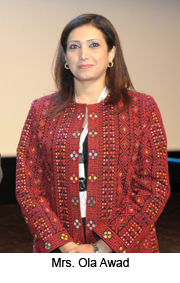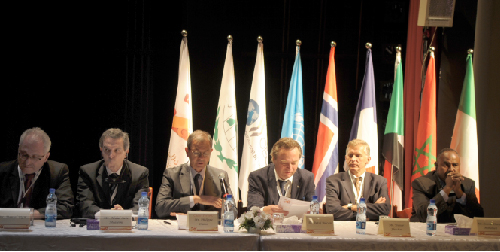Palestine sets a precedent in the Arab region by assuming the Presidency of the International Statistical Committee – the first time in nearly three decades
For the first time since the Oslo Peace accord and the inception of the Palestinian Authority and the launching of the process of building Palestinian national institutions, Palestine hosted the International Conference on Official Statistics, entitled ‘Efficient Statistical Information Systems for State Building’. The conference was held in Ramallah under the auspices of His Excellency President Mahmoud Abbas, and was a significant achievement for Palestine in 2013. Palestine has been elected President of the International Committee for Official Statistics for the period 2015-2017 – this announcement also sets a precedent by electing an Arabic National Statistics Office (NSO) with a female President as head of the committee for the first time since 1985.
 Mrs. Ola Awad, President of the Palestinian Central Bureau of Statistics (PCBS), addressed the audience with great zeal, telling of the challenges faced by the PCBS and its staff throughout the years and the crippling constraints imposed by the Israeli occupation that rendered the work of this bureau a rather daunting and impossible task. The accumulation of hard work and perseverance throughout the years and the legislative and leadership support culminated in the launching of an approved and official ‘National Strategy for 2014-2018’, developed through an inclusive approach that engaged various stakeholders (referred to as ‘partners’) with the strategy-making process. This was complemented by a national monitoring system as a tool for monitoring, evaluating and recording socio-economic and environmental data in line with the national strategic vision and objectives. This system aims to provide a comprehensive database for different sectors in collaboration and coordination with public sector institutions, the private sector, and other stakeholders in an effort to service their needs in terms of statistical data and derive relevant indicators to monitor national policies and plans.
Mrs. Ola Awad, President of the Palestinian Central Bureau of Statistics (PCBS), addressed the audience with great zeal, telling of the challenges faced by the PCBS and its staff throughout the years and the crippling constraints imposed by the Israeli occupation that rendered the work of this bureau a rather daunting and impossible task. The accumulation of hard work and perseverance throughout the years and the legislative and leadership support culminated in the launching of an approved and official ‘National Strategy for 2014-2018’, developed through an inclusive approach that engaged various stakeholders (referred to as ‘partners’) with the strategy-making process. This was complemented by a national monitoring system as a tool for monitoring, evaluating and recording socio-economic and environmental data in line with the national strategic vision and objectives. This system aims to provide a comprehensive database for different sectors in collaboration and coordination with public sector institutions, the private sector, and other stakeholders in an effort to service their needs in terms of statistical data and derive relevant indicators to monitor national policies and plans.
The Conference, organised by the Palestinian Central Bureau of Statistics, was attended by a wide national and international audience keen on sharing experiences and knowledge, and to partake in networking to enhance statistical performance and effectiveness in their respective institutions. Speakers and experts came from diverse backgrounds representing multilateral, regional and national organisations, and engaged the audience with presentations and discussions that tackled pertinent issues related to official statistics. Topics presented and discussed throughout the conference sessions included; statistical literacy and the rising importance of the role of communications in disseminating and explaining statistical data to policy-makers and the public at large, trends in information technology facilitating the interactive communication of statistical information, challenges for official statistics in unstable circumstances, capacity building in this area, and UN initiatives to establish, monitor and coordinate global indicators.
Improving lives through better statistics: unleashing the potential of communication and social media
Presented by: Daniel Byk
 Public statistics dissemination and communication is an issue that is widely debated among statisticians and the public sector nowadays as one of the key elements to state building. Although official/public statistics are part of day-to-day priorities, practice and theory supersedes their communication and dissemination in general. It is noticeable that day-to-day operations focus on efficient collection, analysis and interpretation of data gathered and their organization in statistical information systems but stop short of their adequate and efficient dissemination. Typically these efforts are not matched with efficient recruitment of staff with much needed skills in communication and dissemination of statistical information. The ensuing lack of skills in communication of statistical data is directly related to the education of public sector staff and journalists using and interpreting statistical data. It is quite noticeable that their education is heavily skewed towards statistics and economics and lacks the relevant communication skills for reaching out to the different stakeholders and the public at large. This education-skills gap persists among journalists and statisticians as university curricula do not equip statisticians, economists and journalists with communication and dissemination skills that enable them to create an impact through public statistics by improving people’s lives. The negative outcomes of this gap is translated into inadequate dissemination and communication of public statistics, over-emphasis on certain measures, notably GDP per capita, under-use of much available data and poor or ineffective use of multiple media tools to explain and communicate pertinent data.
Public statistics dissemination and communication is an issue that is widely debated among statisticians and the public sector nowadays as one of the key elements to state building. Although official/public statistics are part of day-to-day priorities, practice and theory supersedes their communication and dissemination in general. It is noticeable that day-to-day operations focus on efficient collection, analysis and interpretation of data gathered and their organization in statistical information systems but stop short of their adequate and efficient dissemination. Typically these efforts are not matched with efficient recruitment of staff with much needed skills in communication and dissemination of statistical information. The ensuing lack of skills in communication of statistical data is directly related to the education of public sector staff and journalists using and interpreting statistical data. It is quite noticeable that their education is heavily skewed towards statistics and economics and lacks the relevant communication skills for reaching out to the different stakeholders and the public at large. This education-skills gap persists among journalists and statisticians as university curricula do not equip statisticians, economists and journalists with communication and dissemination skills that enable them to create an impact through public statistics by improving people’s lives. The negative outcomes of this gap is translated into inadequate dissemination and communication of public statistics, over-emphasis on certain measures, notably GDP per capita, under-use of much available data and poor or ineffective use of multiple media tools to explain and communicate pertinent data.
To address these negative outcomes there is a need for adjusting recruitment policies by incorporating communication skills as a criterion for selection and for capacity building in communication and dissemination. The Australian Bureau of Statistic approach could be emulated in terms of its extensive use of social media to disseminate and communicate public statistics to stakeholders notably to the public in a targeted manner that is suited to their needs and capabilities, which is termed ‘statistical literacy’. Internet, tablets, social media tools including Facebook and Twitter are extensively used in a creative manner to engage in two-way conversations with the public on most important findings related to socio-economic indicators which raises their awareness and facilitates their understanding of the socio-economic setting they live in and its implications for decision-making on policy-makers. For instance, infographics are used on Facebook to communicate in a comprehensible manner data from most recent findings through surveys conducted by the Australian Bureau of Statistics. Simple interactive games and infographics are the main communication tools used to communicate on Facebook. Infographics are visual presentations that are appealing, engaging and interesting and offer an opportunity for creative display of important data. For instance, an attractive infograph with colorful designs displays a graph for the record of number of births to women over 40 years of age over ten years (which assumed an increasing trend since 2011) and refers to the official publication on statistics on birth and fertility in Australia. Another attractive infographic displays that in one year (2011-2012) Australians drove 232 billion km, which is 5.8 million times around the world! Comments and feedback on these indicators are used to enhance statistical performance and research empowering the public to become part of the statistical process. According to Daniel Byk, integrated statistics communications using both traditional and new media should be the approach of other countries and capacity building for integrating communication through media needs to be integrated into national public statistics activities.
Dissemination of Statistical Literacy in Italy
Presented by: Professor Tommaso Di Fonzo
 The National Institute of Statistics School (Istat) is an initiative in Italy that aims to help young citizens understand statistics and data by making statistical information more accessible and comprehensible for users in general. Professor Di Fonzo asserted that in our information society statistical literacy is very important as understanding statistics is part of becoming citizens in the full meaning of this term.
The National Institute of Statistics School (Istat) is an initiative in Italy that aims to help young citizens understand statistics and data by making statistical information more accessible and comprehensible for users in general. Professor Di Fonzo asserted that in our information society statistical literacy is very important as understanding statistics is part of becoming citizens in the full meaning of this term.
People who are not able to read and critically evaluate statistics are not able to be citizens in the full meaning of the sense. To increase people’s statistical literacy, Istat established the Advanced School for Statistical Literacy as a permanent unit answering to the President of Istat with the mandate of providing professional training, vocational education and skills building to the Istat and public administration staff, staff of foreign institutions, staff of private sector enterprises, and teachers, students and university graduates.
Currently, with regard to the dissemination of statistical literacy, the main target is citizens, namely school students (Secondary and upper secondary school students), university graduates and journalists. This orientation is based on the premise that journalists and information management specialists can be extremely important allies to improving statistical dissemination and communication. They are mediators between experts and the general public and thus need to have the competences to use innovative visualisation tools and to deal with the data in an effective manner. This would enhance the quality of information emerging from different media vehicles especially today’s digital media and social media. A virtual lab was established by Istat to break down the wall separating ‘young people’ from ‘statistics’. It is an innovative tool for developing statistical skills with the help of interactive dynamic visualisation tool (Statistics eXplorer). This virtual lab will be open to teachers and students’ contributions through the eXplorer platform – to which users can subscribe. The use of Web 2.0 tools and eXplorer enables visualisation and storytelling through dynamic charts and tools. Users with different backgrounds who are not specialists in statistics take part in the creative discovery of statistical data knowledge which is a process that develops a shared understanding with other users, which allows for an agreement reached for a story that can be published in the public domain with a snapshot that highlights data of particular interest, thus guiding others to visual discoveries of statistical information. Cooperative learning is another important feature of this tool because teachers and students or simple users can create stories together using uploaded data.
As to whether there exists a gender skills gap in statistical literacy and education in Italy, Prof. Di Fonzo noted:
‘There is no gender-related statistical gap in education in Italy but there exists a gap between male and female statistical education as is common in other technical and scientific domains’.
As to integrating media and communication to statistical university curricula in Italy, Prof. Di Fonzo pointed out that no efforts in this direction have been made so far.
Challenges for official statistics acting in unstable circumstances
Presented by: Jan Robert Suesser
 Meeting its obligation as one of the key players in the construction of the State legitimacy is a basic challenge for official statistics. The Palestinian Central Bureau of Statistics (PCBS) has faced unstable conditions and surmounted prohibitive conditions and obstacles since its inception twenty years ago. The PCBS had to build its institution from scratch and deal with the particularities of operating in an unstable environment in a nascent public sector. These complexities did not give way to a progressive path of knowledge and experience accumulation as the PCBS had no choice but to reach maturity from the moment it was born. During those first decades, the PCBS had to develop approaches and methodologies to deal with instability and lack of sovereignty in many areas, instill a culture of compliance among institutions and the private sector, and gain trust and legitimacy. Even best-in-class practices are not sufficient when building statistical capabilities under adverse conditions or during statistical transition as new ways have to be found to deal with these conditions. Moreover, another major challenge is finding practical ways of successfully interacting with economic actors and individuals to produce meaningful reliable information despite a culture of non-compliance. This is explained by the fact that enterprises feel no obligation or commitment to register formally or answer the national office of statistics (exactly as happened in Central Europe in the early ’90s after the fall of the Socialist bloc). A third challenge faced in Central Europe, and similarly applies to the Palestinian context, was gaining public trust in the data they were disseminating and gaining legitimacy of functioning in a democratic framework. It was also to be shown to be contributing to the legitimacy of public institutions and the national institutional framework. The role of PCBS in informing citizens and public debates and decision-makers about the state of the economy and social issues with accepted, reliable and adequate data was more pressing than ever for the creation and functioning of national institutions and for informing policy-making.
Meeting its obligation as one of the key players in the construction of the State legitimacy is a basic challenge for official statistics. The Palestinian Central Bureau of Statistics (PCBS) has faced unstable conditions and surmounted prohibitive conditions and obstacles since its inception twenty years ago. The PCBS had to build its institution from scratch and deal with the particularities of operating in an unstable environment in a nascent public sector. These complexities did not give way to a progressive path of knowledge and experience accumulation as the PCBS had no choice but to reach maturity from the moment it was born. During those first decades, the PCBS had to develop approaches and methodologies to deal with instability and lack of sovereignty in many areas, instill a culture of compliance among institutions and the private sector, and gain trust and legitimacy. Even best-in-class practices are not sufficient when building statistical capabilities under adverse conditions or during statistical transition as new ways have to be found to deal with these conditions. Moreover, another major challenge is finding practical ways of successfully interacting with economic actors and individuals to produce meaningful reliable information despite a culture of non-compliance. This is explained by the fact that enterprises feel no obligation or commitment to register formally or answer the national office of statistics (exactly as happened in Central Europe in the early ’90s after the fall of the Socialist bloc). A third challenge faced in Central Europe, and similarly applies to the Palestinian context, was gaining public trust in the data they were disseminating and gaining legitimacy of functioning in a democratic framework. It was also to be shown to be contributing to the legitimacy of public institutions and the national institutional framework. The role of PCBS in informing citizens and public debates and decision-makers about the state of the economy and social issues with accepted, reliable and adequate data was more pressing than ever for the creation and functioning of national institutions and for informing policy-making.
Particular challenges faced by the PCBS, that represents a case in point in statistical development under adversity, have been in place since its inception in 1993 – when building a national statistical system was estimated to have a feasibility equivalent to zero on paper!
Demographic and socio-economic data were non-existent and in the absence of a statistical culture and statistical work being stereotyped as ‘taxation’. The National Bureau of Statistics had to operate in a fragmented area with partial sovereignty, restricted movement of people meant that daily operations were hampered by trenches, checkpoints, curfews, permits, settlements, and closures and lack of access to Jerusalem. These constraints have not dissuaded the Palestinian leadership and statistics staff from doing their job in the best possible way as they believed that the sky was the limit – even if factors on the ground curtailed its progress.
Their job was rather overwhelming as they had to serve multiple national priorities through their work including poverty, job creation, economy, security, food security, demographic census, education, health, infrastructure and communication.
The approaches created to gather data had to be relevant and flexible in dealing with emerging situations at the same time there was a need to focus on capacity building and public mobilisation. PCBS knew the business of statistics from the outset and succeeded in establishing a national identity through a strong national presence and demonstrating commitment to state building and determination to gather and analyse important data in line with quality frameworks and international best-practices. Statistical performance developed since 1993 from production of non-existent data and the building of a statistical system to marketing data to stakeholders, to partnering with them, progressing to strategic planning and aiming at achieving statistical and ICT literacy.
Daniel Byk, a statistical expert and speaker at the conference, comments on the achievements of the PCBS:
‘Their success in building a national statistics system that addresses the particular needs of Palestine and in devising their national strategy and monitoring system in such challenging conditions shows that they must continue what they are doing. Palestine is ahead of other countries operating in less adverse conditions, or in normal situations in terms of statistical achievements, and could become among the leading countries in terms of statistical performance.’
In the same vein the United Nations Statistics Division congratulated the PCBS for its achievements as noted by Mr. Mathias Reister, Senior Manager for Development Indicators at the UN division:
 ‘There is a need to attract policy-makers to use official statistics in their decision-making process to scientifically measure and monitor the impact of social and economic indicators. For the past twenty years, PCBS has led national efforts for developing the national statistical system using international standards.’
‘There is a need to attract policy-makers to use official statistics in their decision-making process to scientifically measure and monitor the impact of social and economic indicators. For the past twenty years, PCBS has led national efforts for developing the national statistical system using international standards.’
Mrs. Ola Awad, President of PCBS, pointed out that social and economic indicators are gender sensitive and PCBS has an accessible database on their website and regular publications. Regular meetings with different stakeholders are held to address their needs and ensure relevance of data. The launch of the National Statistics Strategy and monitoring system marks twenty years of hard work and dedication by the PCBS and ongoing efforts to continue development towards statistical literacy and the use of information and communication technologies in data collection, analysis and dissemination.
The Millennium Development Goals (MDGs) – a collective inspirational vision and an overarching global framework for development around the globe
The Millennium Development Goals are a set of concrete time-bound targets that could be monitored statistically by robust development indicators led by the United Nations at the global level. Targets are set for reducing poverty, improving access to safe drinking water, and improving the lives of 200 million slum dwellers have been met. Remarkable gains have been made in the fight against malaria and tuberculosis and in the area of primary education. Strengthening the use of statistics in monitoring and decision making through the Millennium – in fact, strengthening statistical capacity systems and methodologies, compilation and use of quality data for monitoring and policy-making at both national and international levels – are all main concerns of the Millennium Development Goals (MDGs) and the post 2015 agenda. The United Nations Statistical commission (UNSC) has been providing guidance and leadership in monitoring progress towards the achievement of MDGS from the outset and will guide and lead the responses to statistical needs arising from the post 2015 agenda. Some weaknesses pertaining to the MDG framework have been manifested, namely the lack of clear numerical specification for some targets and indicators and the perception that they were laid using a top-down approach and were hard to interpret at the national level. Some were not sensitive to inequalities, gender and local disparities with the persistence of disparities between and within countries.
The post 2015 Development agenda will increase the importance of statistics and its critical role
Efforts to initiate thinking about the global post 2015 development agenda led to an inclusive bottom-up process to develop sustainable development goals (SDGs). The statistical community has been lending its expertise in the discussions on the SDGs from the outset incorporating lessons learned from MDG monitoring. For instance, future endeavours would entail work on broader measures of progress to complement GDP in order to better inform policy decisions. This new orientation represents significant extension of data requirements and possible redirection of focus to cover social, economic and environmental dimensions and possibly governance as a fourth dimension. Indicators covering these dimensions are extremely ambitious from a measurement perspective, and would pose challenges for even the most advanced statistical system. Data gathered might need to be disaggregated by gender, income, geography, disability and other categories to make sure that no group is left behind and a shift away from GDP as a key indicator might be expected, coupled with a move towards real-time monitoring (better timeliness).
Once Sustainable development targets have been established and approved, statisticians will need to derive appropriate targets and measurable indicators. National priorities will have to be aligned with these goals for global monitoring. Appropriate monitoring systems will have to be agreed on and established at national, regional and international levels. National Statistical Offices (NSOs) will have the coordinating function and the inclusion of new data sources and providers such as mobile technology and big data will challenge the traditional statistical approaches. Monitoring and achieving these new goals and targets will require the adoption of new integration, dissemination and communication methods.
Further investment in national statistical systems, in a country’s capacities for data collection, processing and analysis will be necessary in the new statistical areas such as governance. A NSO, supported by the international statistics community and in partnership with other stakeholders, will need to lead efforts in strengthening and developing new data sources and in ensuring statistical quality and reliability. Clearly, statistics will become the source of power and empowerment in the near future.
 As to Middle Eastern countries, statistics assumes a key role in certain countries such as Morocco, Turkey and Palestine in informing decision-making and improving socio-economic conditions. However, in some countries its role is limited to demographic census and falls short of improving policy-making in socio-economic spheres as indicated by the journalist, Mr. Osama Eltayeb Mohamed, who was one of the speakers at the conference.
As to Middle Eastern countries, statistics assumes a key role in certain countries such as Morocco, Turkey and Palestine in informing decision-making and improving socio-economic conditions. However, in some countries its role is limited to demographic census and falls short of improving policy-making in socio-economic spheres as indicated by the journalist, Mr. Osama Eltayeb Mohamed, who was one of the speakers at the conference.
As to challenges for official statistics in the Organization of the Islamic Conference (OIC – the second largest intergovernmental organization after the United Nations with 57 member countries), Professor Savas Alpay, Director General of SESRIC, a subsidiary of the OIC based in Turkey, presented the work of his organization and the challenges it faces. SESRIC has a mandate of coordinating statistical activities of the organization, namely capacity building and research. The organization keeps the most comprehensive database for all OIC member countries, available to them on the OIC website and freely accessible. The secretariat of the OIC statistical commission (established in 2010) meets annually with heads of national statistic offices of OIC member countries with the aim of enhancing member countries’ statistical performance, as this is a critical area for developing countries. Sound policies require a strong, reliable and adequate database for informed decisions. The statistical commission also generates technical cooperation activities by matching the countries in terms of their capacities. Every year a survey is conducted to identify member countries’ statistical training needs and the countries that can provide training are identified. Countries are then matched according to skills, needs and language. The training programmes are held on site in NSOs. Much needs to be done in OIC countries in terms of capacity building, especially in under-developed countries where problems in collecting basic data exists. The bright side of the story is that there are OIC member countries that are developed in terms of technological advances in statistics and in following state-of-the art methodologies and approaches. This creates an opportunity to benefit from these countries’ expertise in countries with weak capacities.
Infrastructure and budgetary constraints are among the most cited problems. The World Bank has developed a statistical and performance framework with three major indicators: statistical methodologies, sources, and periodicity of data collection. In general, all OIC member countries rate below the world average when measured against these indicators. Yet there are ten to eleven countries in the OIC rated as having ‘high performance levels’ and ‘strong capacities’. Turkey, Malaysia and Palestine are among the leading countries that are doing well as they demonstrate strong capacity and performance.
To cope with these differences and address statistical needs, SESRIC cooperates with the Islamic Development Bank in organising training programme. One thousand experts have been trained so far. Surveys are conducted beforehand to identify needs and to address them through tailored training programs.
Technology is a vital tool for communicating statistics. Mr. Sander Duivestein, from the Dutch International Research Institute of Sogeti, comments:
‘Although it is getting under our skin with information on people becoming so readily available on digital communication channels and the overwhelming amounts of data generated minute by minute. It also augments our senses (Google glass and iPhone). Yet technology still needs to be embraced by companies and public sector organisations and skills need to be developed as embracing new technologies is still resisted in many places. The advent of Web 3.0 with ubiquitous networks of devices that are worn or glued under the skin will also herald a new era of revolutionary communications as devices would be able to read brain memory through translating brain waves, and glass surfaces would become touch devices for interactive communication instead of tablets, desktops, iPhones and laptops.’



























